I am an unabashed fan of the Commander format. That should be apparent as we are just five weeks out from the three year anniversary of this column. Multiplayer casual Magic has always been the primary way I’ve played the game, and so aside from some creative restrictions on deck construction, adapting to the format came across much more like a natural extension of that process rather than some foreign concept to learn anew. It also hasn’t hurt that due to the meteoric rise of Commander in popularity over the last few years, it has also become my play group’s increasingly preferred style of Magic.
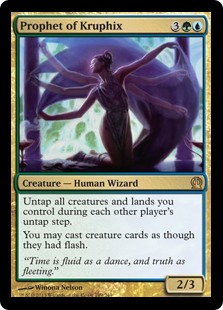
Just skip the Prophet, okay?
Yes, three years is a very long time to be speaking week over week about specific card choices for the format, paling only in comparison to my tenure as a 21 year Magic player. While the Monday Magic column has occasionally been interspersed with segments that don’t fall into the Card Of The Week purview (such as our coverage of Modern Masters & Modern Masters 2015, the Ten Most Versatile Cards In Commander 2014, and the surprisingly popular four part series on how not to be a jerk in EDH), the vast majority of the time the goal has been to provide a worthwhile card for Commander decks both from the game’s past (i.e. outside of Standard) and affordable to acquire, with each of the card selections framed around a plethora of Magic-related anecdotes.
That is not to say that Commander-related coverage has been universal or ubiquitous. Indeed, there are a number of topics about Commander that, for one reason or another, are often glossed over or consciously avoided. Usually, however, this comes down to the fact that not every topic can be properly addressed in one article more than lack of desire to talk about them. Legendary creatures are rarely chosen as the spotlight cards, for instance, because talking about a card’s usefulness as part of a 100 card deck versus as the Commander itself is generally two vastly different things which focus on different aspects of the card. Simply put, it’s much easier to delve into one card’s worthiness within a deck than it is to explain the myriad uses of a card at the helm. It’s the same logic as to why I typically avoid going into detail about how well any given card will combo off this component or that deck addition: it’s a rather large rabbit hole to go down.
I’ve also surprisingly never really gone into detail about how to build an EDH deck.
Until now.
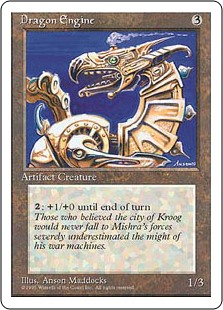
All aboard the Dragon Engine!
I do not pride myself on being a great deck builder. I’ve always been much better at developing a deck than designing one. Give me a precon or a newly minted deck that needs tweaking and I can help make it better. I see the pieces moving and recognize where there can be more optimal substitutions without changing the flavor of the deck or having it tip over into brokenness.
Coming up with a brand new deck from scratch…not so much. Many of you out there can throw a deck together in an afternoon, and I’m rather envious of that ability. It’s not my strong suit, and it’s further compounded by routine bouts of analysis paralysis as a result of having a sizable card inventory. I routinely run into the problem that there are so many good toys out there for any given deck and so few slots available.
I also build decks in the mindset that they are going to stick around; I rarely dissemble decks once made. As a result, deckbuilding is often a long process for me. Further compounding the problem is that I don’t devote nearly as much time to making or tweaking decks as I used to, let alone Magic in general. Life, it’s a thing.
Consequently, although I’ve been playing Commander for years now, this is why I only have five homebrewed decks in addition to eight or nine unmodified precons, being Angus Mackenzie, Karn, Silver Golem, Eight-and-a-Half-Tails, Melek, Izzet Paragon, and Ramses Overdark.
None of this is better exemplified than the fact that the most recent one, Ramses, took me a year to construct, more than doubling my previously held record of indecisiveness by seven months. And he’s hardly the most potent deck I have. Most of this was lack of time to work on it, but still.
I since resolved that the next deck would take far less time. In fact, I resolved that my next Commander deck would be the fastest built one yet. It may not be made-in-a-day fast, but I was hopeful, nay, insistent that it would be fast for me – which meant under two months.
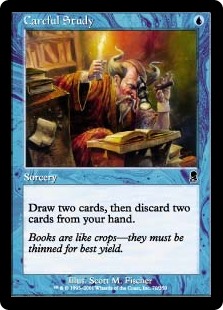
Come and learn a thing or two. Or not. We’ll see.
I also realized that going through the deckbuilding process would be a wonderful thing to chronicle. For one, it has the potential to be a great learning tool out there to those such as myself that don’t have the innate gift of throwing a pile of cards together in an afternoon and shaking out a workable deck. For another, such an ordeal would force myself to stay stay focused on actually getting the deck made in the (relatively) expedient manner I desired. This proved too serendipitous to turn down.
Moreover, I thought it might be fun to crowdsource some of the design ideas from you, seeking your input as the deck takes shape.
And so here we are, about to embark on such a journey.
…I just needed to come up with a Commander worthy of such attention…or did I?
The Ground Rules
While it’s true that everyone approaches deck construction differently, there are a few common best practices for most people:
- To Thine Own Self Be True: Build a Commander deck that you are going to have fun with. Some people love crazy off the wall combo decks with 18 moving pieces. Other people love dumping out ridiculous amounts of token creatures. A deranged few love coin flipping or goats or doing weird thing with flying hippos. Focus on something you’re going to enjoy more than what may be a popular choice around you.
- Top-Down or Bottoms-Up: When deciding on how to proceed with your deck, you have to choose very early whether you want a ‘top-down’ Commander, where you build the deck around it, or a ‘bottoms-up’ Commander, where you build a deck to do a certain thing and pick a Commander mostly to facilitate its color identity.
- Either are acceptable, contrary to what some may say, though most of my decks tend to be top-down personally.
-
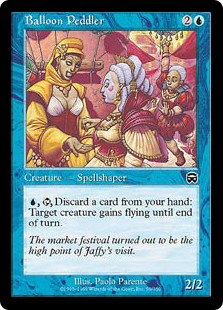
Balloon Peddler is too perfect a nickname for secondary market companies that drive up prices unnecessarily.
Workable Inventory: Part of the fun of EDH is being able to change, alter, and improve your deck over time. However, I recommend starting with cards that you have or can get easily and cheaply and then upgrade from there. The last thing you want to do is buy a bunch of expensive cards for a deck that doesn’t materialize, or worse, doesn’t work.
- Of course, this logic often works against me. Since I collect sets in addition to playing, I have access to around 90% of all playable cards in Commander, with the ones missing mostly either from the earliest days of the game or the most recent tournament staple cards that demand overly inflated prices.
- Follow Wheaton’s Law: Don’t be a dick. EDH is supposed to be a casual format, and you’re usually going to be playing with friends. If you make a deck that’s simply unfun to face but continue to do so against friends and foes alike (and there’s plenty of you out there who do for some twisted reason), it doesn’t win you any flavor points. Great, your Zur The Enchanter deck roflstomped your play group into non-enjoyment again. Consider me unimpressed. Decks can be powerful without being table warping and off-putting to play with. Ignore that to your own detriment.
- Also, consider reading the aforementioned articles about how not to be an ass in EDH. Just saying.
Pretty straightforward generalities there. Yet I also give myself extra parameters on what will and won’t be acceptable to do as part of my own deck-making process. This provides extra restrictions that help ensure I’m going to make a build a deck that suits me. You may find it creative, useful, or even fun to have a few of your own requirements. These are most of mine and are pretty consistent with any deck I make:
- No .Netdecking: It must be a unique deck of my own doing. If I’m just copying someone else, what’s the freaking point?
- No Duels: I only ever build for multiplayer games and use the normal Commander rules. I don’t use the French / Dual Commander system. (Frankly I find 1v1 Commander counter to the entire spirit of the format.)
-
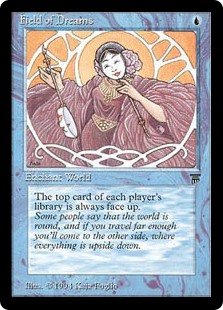
Melek uses Field of Dreams over Lantern of Insight simply because it’s Weirder. Get it? A ha ha…
Limited Unlimitedness: Nowadays I try to actively avoid having many ways to ‘go infinite’ with things. They may be insanely powerful, but I personally don’t find them as fun as I used to. In the game’s earlier years it was more difficult to pull off and rarer to see, so it was exciting. Yet there are innumerable ways to accomplish it now, and most end the game so anticlimactically. Sometimes they happen by accident, but I try to keep infinite combos to a minimum.
- Factor In Politics: Your play group will different, but I always factor in table politics, either in the form of including cards that cater to them or avoiding cards that are just going to make me a target.
- A Soupçon: Every one of my decks has a little personal flare to it, often in at least one card that’s in there for nostalgic or flavor reasons more than for synergy or comboing – though those aren’t mutually exclusive.
And there we have our starting point. It seems like a lot of barriers, but most of them are common sense when you get right down to it. If nothing else, remember that Magic is about having fun, and your deck should reflect that. Even if only one of you can walk away from the table alive.
Part One: The Infodump
With the ground rules out of the way, the first thing I needed to do was come up with a Commander. My personal style of play is as a tinkerer, and so I generally gravitate towards Commanders that aren’t capable of single-handedly winning the game by their sheer presence. I like Commanders that make me think more than those with simple strategies (i.e. Kaalia of the Vast, Bruna, Light of Alabaster or straight up bruisers (i.e. Ruric Thar, the Unbowed).
Second, I wanted to pick something to help color balance my existing decks. Given how woefully underrepresented Red and Green were among my decks, and the recent deck was yet another one with Blue in it, I gave myself the requirement of selecting a Commander that was Red and / or Green and did not have Blue in its color identity.
Third, I wanted a tricolor deck. The last four decks I’ve constructed were single color, no color, and two dual colors. I hadn’t made a tricolor deck in a while and wanted a change.
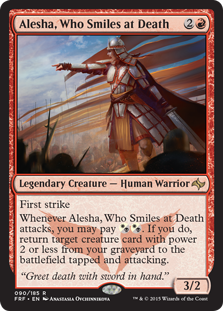
There she is. Let’s do this!
After some asking around and doing my research, my original path led me to be leaning strongly towards Anafenza, the Foremost. In fact, I had practically made up my mind before I was challenged to consider Alesha, Who Smiles at Death instead. Alesha may be a more commonly seen Commander than Anafenza, the argument went, but it also required more hoops to jump through to be effective. Both of them are combat-based Generals – of which I currently have none – so either one was already going to be outside my comfort zone. Still, I couldn’t pass up the opportunity for the extra difficulty in doing so.
Yeah, I went for more complex.
I’ve been playing a long time, and simple deck methodologies don’t excite me nearly as much as more complex, or even convoluted options. I’m a little crazy like that.
So Alesha it was. Step One complete. We’re done here, right?
No?
Ugh.
Okay…finneeeee. Let’s keep going.
Alesha may be the first transgender character in the game, but she’ll also be my first combat-based EDH deck. Since Alesha will be another top-down Commander, the first thing I like to do is begin by compiling a list of cards by type that fit the base criteria of what the card is trying to do. Alesha’s trick is that she can return a creature to the battlefield of power 2 or less when attacking, and that seemed like the logical place to start.
Like most people, I do most of my card searches on Gatherer, Wizard’s own search engine. It’s not the only card search engine available, but it has one of the more robust search protocols around and is easier to use for some of the more advanced criteria you may need than most others. That is where I got my initial list of creatures. I searched for all cards that fit Alesha’s color identity (meaning no Blue or Green cards or their color symbols) and whose power was 2 or less. The readout came back with just a mere 2,850 or so creatures that fit this description. That’s a lot of cards.
…which I then spent the next day pouring through.

It’s also pretty tiring
For the record, in a case like this I don’t believe this open-ended approach is the most ideal method for most people. It’s often easier to start with a smaller sample pool, such as cards you may own or a specific subset of a larger search result.
I went through them all the same, but I actually consider this approach to be a failure on my part, as while it plays into my natural enjoyment of building lists, it also exacerbates that problem of analysis paralysis when it comes to choosing from such a large pool of options. As such, for something so generalized as small creatures in your color, I suggest taking a different approach than I and save yourself a lot of my own troubles.
I then jotted down every card that I felt could potentially play into Alesha’s ability in even the remotest situation in EDH. For list building I suggest online deck builders like Essential Magic or TappedOut.
My focus was primarily – though not exclusively – in three criteria. First, I focused on creatures with Enter The Battlefield or death triggers. Alesha brings creatures back from the graveyard, which helps in the first case, but they’re also tossed right into combat and may not survive, which helps in the latter case. Second, I typically avoided creatures who were only helpful if they had tap abilities. Tap abilities are certainly useful if I’m going to be casting them and having them sit around on the board (which undoubtedly will happen), but if thrust back to life in the middle of combat they may was well be elaborate Grizzly Bears. Third, I tried to keep an eye out for creatures who are power 2 or less in the graveyard but get bigger on the battlefield, either in the case of static buffs or +1/+1 counters.
When all was set and done, I had a list of 332 creatures. This is what I call my raw infodump list. While it’s a big reduction from the almost 2900 originally, it’s still incredibly unwieldy, especially since you’re going to use at most, what, 40 creatures? Probably less. But it gives us a starting point.
I also left out Master of Cruelties. Powerful? Absolutely. Even remotely fair? Nope, and quite unfun to play against as well. Alesha is already going to have issues with staying alive as it is without people knowing a Master of Cruelties could come popping out of the graveyard at any moment. No thanks.
I then went through more haphazardly and came up with a smaller (and more incomplete) list of creatures that Alesha can’t bring back who still may be helpful otherwise in one form or another. Typically these tended to be creatures I thought up or did quick searches on that will either a) help my creatures stay alive, b) punish those for killing my creatures, c) help bring my creatures back, or d) simply kill my opposition’s creatures.
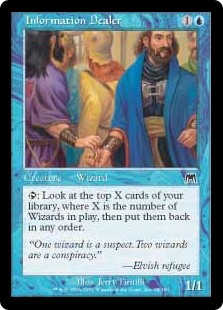
I have all the info you need
What follows is a list of those two card readouts – 365 creatures in all. I have to stress that this is the very beginnings, and there’s a lot to be weeded out. By the next installment we are going to do just that. We will whittle this list down significantly to a more manageable number, much like cutting players from a sport team’s training camp, and then look at why we kept some of the creatures we did. Ideally for me this shouldn’t be more than about 60-70, which is still more than twice what I’ll need, but that sample pool provides a much better platform to work with as we move into the next phase of deck construction.
Still, that’s an 81-83% reduction. Which means we have a lot of work to do. I invite you take a look through the list yourself, make some mental notes of your own, and next time we’ll compare findings. Sound good? Till then!
Alesha’s Infodump
Alesha-Friendly Creatures
And some of the friends she may be considering:
Alesha's Allies
![]()
Want to talk shop about Building the Dragon Engine, including the cards mentioned? Tell us over on our social media!
Do you have a particular Commander card to suggest for us to shine a future Spotlight on? You can send suggestions to ryan@cardboardrepublic.com
